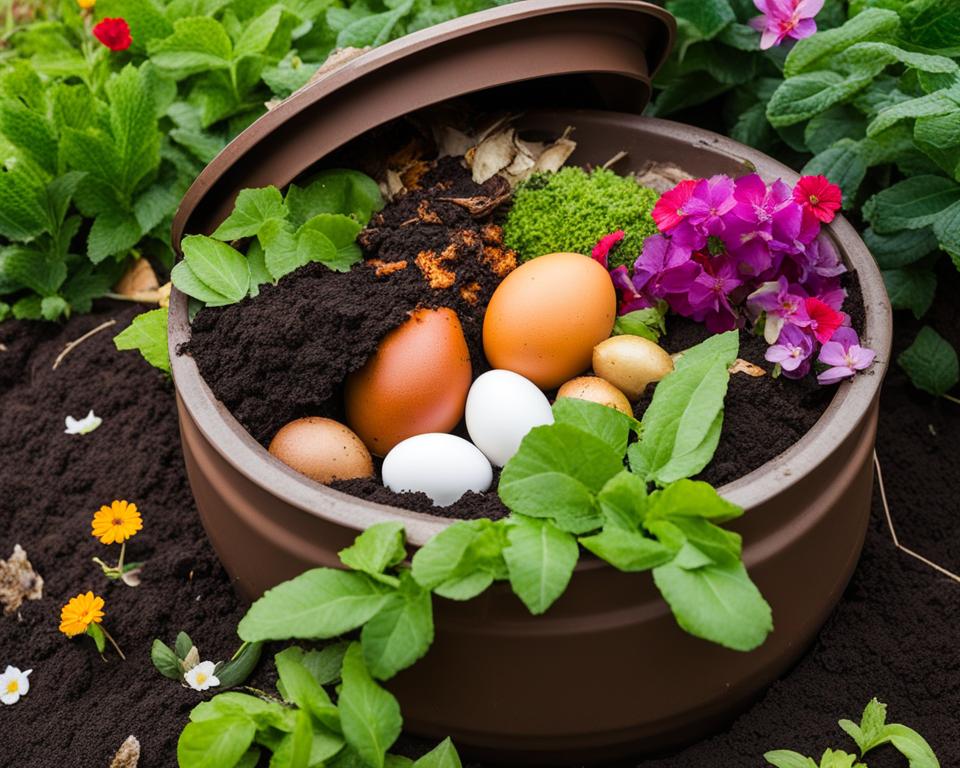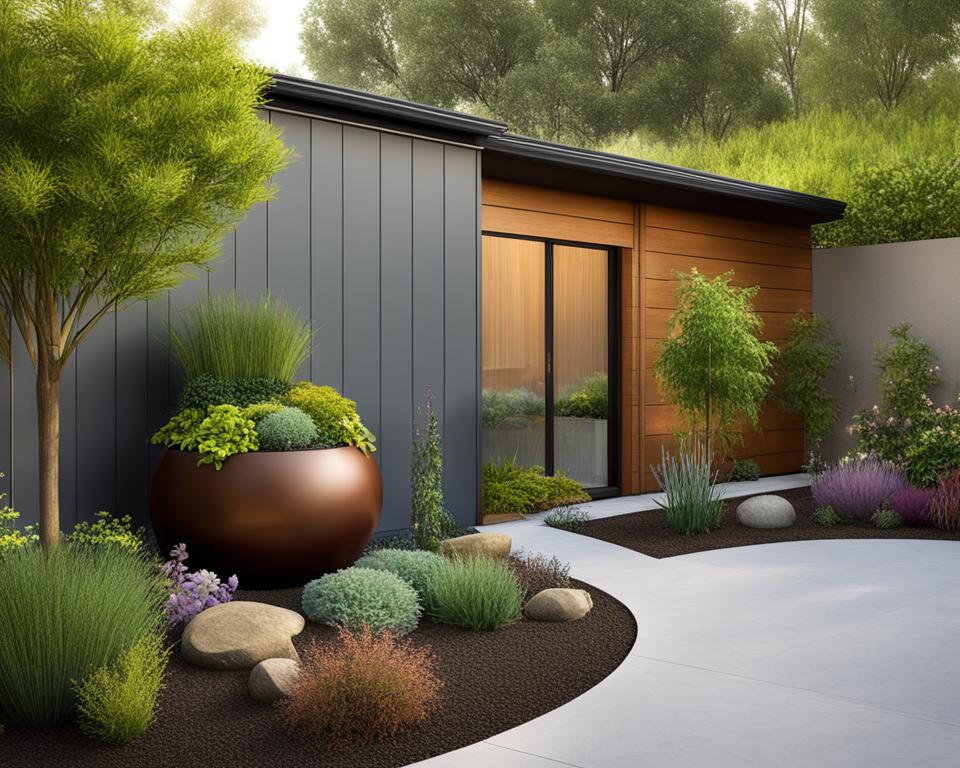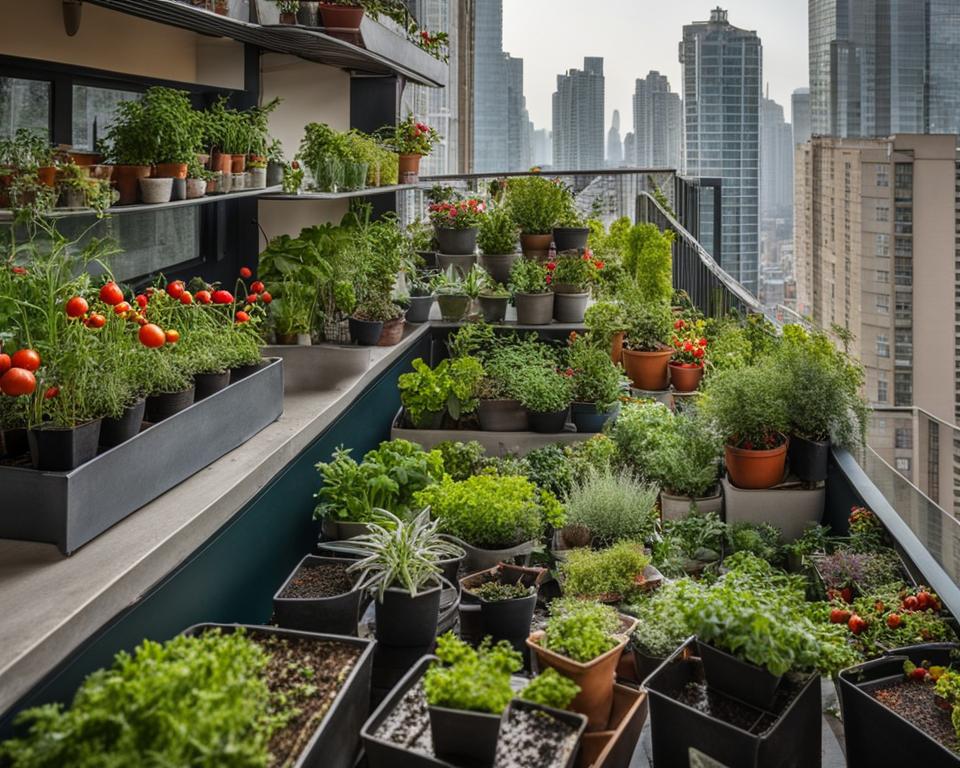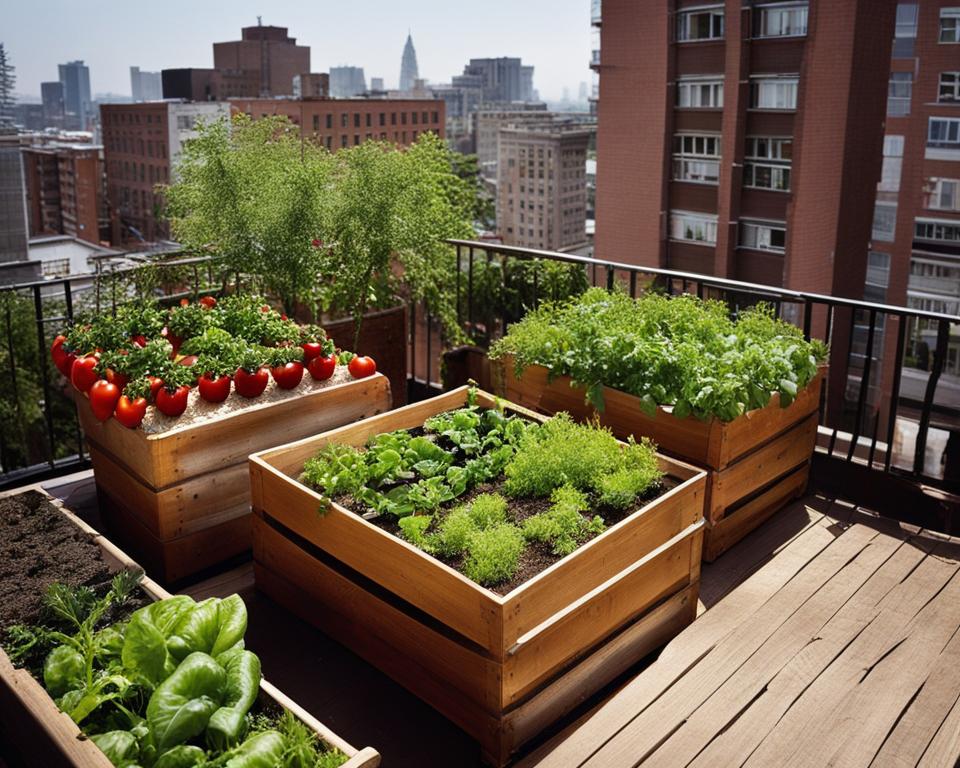Welcome to my guide on urban survival gardening! In this article, I will share valuable tips and insights on how to achieve self-sufficiency through urban gardening. Whether you have a small balcony or a rooftop, you can cultivate your own food and become more self-reliant. With urban survival gardening, you can transform your urban space into a green oasis that provides for your needs. So, let’s dive into the world of urban gardening and discover the secrets of self-sufficiency!
Understanding Urban Homesteading
Urban homesteading is a lifestyle choice that embraces sustainable living and self-sufficiency in an urban setting. It is a way to connect with nature, reduce environmental impact, and create a more resilient and independent lifestyle. As an urban homesteader, I have discovered the numerous benefits of this lifestyle, from growing my own food to reducing waste and embracing renewable energy sources.
One of the key aspects of urban homesteading is the practice of sustainable gardening. By growing your own fruits, vegetables, and herbs, you can have a direct impact on the quality and freshness of your food. Urban homesteading enables me to utilize even the smallest spaces for gardening, whether it’s a balcony, rooftop, or a small backyard. I’ve learned to optimize these spaces by implementing vertical gardening techniques, using containers, and making the most of natural sunlight.
In addition to gardening, urban homesteading encompasses other self-sufficiency practices such as composting, rainwater harvesting, and DIY projects. Composting allows me to transform kitchen scraps and yard waste into nutrient-rich soil for my garden, while rainwater harvesting helps me conserve water and reduce my reliance on city resources. DIY projects, such as building a solar panel or constructing a chicken coop, empower me to take control of my resources and reduce my ecological footprint.
“Urban homesteading is not just a way of life, but a mindset. It’s about taking responsibility for our own needs and creating a sustainable future in our urban environment.” – Anonymous
Embracing the urban homesteading lifestyle has not only made me more self-sufficient but has also fostered a sense of community. I have connected with like-minded individuals through local gardening groups and workshops, sharing ideas, tips, and resources. Together, we are creating a network of sustainable living advocates who are passionate about making a positive impact.
https://www.youtube.com/watch?v=zqdZ1FACQbs
Benefits of Urban Homesteading
- Reduced reliance on external resources
- Fresh and organic food at your fingertips
- Greater control over environmental impact
- Opportunity to connect with nature in an urban setting
- Promotes self-sufficiency and resilience
- Fosters a sense of community and sharing
The Future of Urban Homesteading
As urbanization continues to increase, the need for sustainable living practices becomes more crucial than ever. Urban homesteading provides a viable solution for individuals who want to reduce their ecological footprint and create a more self-reliant lifestyle. By embracing urban homesteading, we can forge a path towards a greener and more sustainable future.
| Urban Homesteading | Traditional Urban Living |
|---|---|
| Self-sufficiency | Reliance on external resources |
| Reduced waste | Increased waste generation |
| Sustainable practices | Environmental impact |
| Community building | Individualistic lifestyle |
Getting Started with Urban Gardening
Urban gardening is a great way to bring greenery into small spaces and cultivate your own fresh produce. Whether you have a balcony, rooftop, or even just a windowsill, there are plenty of options for starting your own urban garden. In this section, I will guide you through the essentials of urban gardening, including container gardening, optimizing small spaces, and selecting suitable plants for urban environments.
One of the key considerations for urban gardening is the choice of containers. Container gardening allows you to grow plants in limited spaces and can be easily adapted to suit your needs. Choose containers that are deep enough for root growth and have proper drainage to prevent waterlogging. You can repurpose various items such as buckets, pots, or even old furniture to create unique and visually appealing containers for your plants.
To make the most of small spaces, vertical gardening is a fantastic technique. Utilize walls or fences by installing vertical planters or hanging baskets. This not only maximizes space but also adds visual interest to your urban garden. Additionally, consider utilizing unused areas like balconies or rooftops to set up your garden. Just make sure to assess the weight-bearing capacity and sunlight exposure of these spaces before planting.
| Container Gardening Tips | Small Space Gardening Tips |
|---|---|
|
|
Choosing Suitable Plants for Urban Environments
When selecting plants for your urban garden, it’s important to consider the unique conditions of urban environments. These spaces often experience higher temperatures, pollution, and limited sunlight. Choose plants that are known to thrive in these conditions, such as herbs, salad greens, and compact fruiting varieties. Additionally, consider growing plants that are low-maintenance and don’t require extensive pruning or fertilizing.
Remember, urban gardening is all about adapting to limited spaces and creating a green oasis in the midst of the city. Embrace creativity and experiment with different techniques to find what works best for your urban garden.
Creating a Survival Garden
When it comes to urban survival gardening, creating a well-designed survival garden is essential. A survival garden is not just about growing your own food, but also about being prepared for emergencies or periods of crisis. By planning ahead and considering various factors, such as plant selection, preservation methods, and sustainable gardening techniques, you can ensure that your survival garden is not only productive but also resilient.
Factors to Consider
When planning your survival garden, there are several factors to consider. First, choose plants that are well-suited to your region and can withstand a range of weather conditions. Focus on high-yield, nutrient-dense crops like leafy greens, root vegetables, and legumes that can provide you with a sustainable source of food. Additionally, consider incorporating perennial plants that will continue to produce year after year.
Another important aspect of a survival garden is preserving food for long-term storage. Explore different preservation methods such as canning, drying, and fermenting to extend the shelf life of your harvest. By preserving your food, you can ensure a steady supply of nutritious meals even during times when fresh produce may be scarce.
Sustainable Gardening
Sustainability is key when it comes to a survival garden. Implementing sustainable gardening practices not only reduces your environmental impact but also ensures the long-term health and productivity of your garden. Consider incorporating techniques like companion planting, crop rotation, and organic fertilizers to promote biodiversity, control pests naturally, and maintain soil fertility.
Water conservation is also crucial in an urban environment. Explore options for rainwater harvesting to provide a sustainable source of irrigation for your survival garden. By utilizing a rain barrel system, you can collect and store rainwater, reducing your reliance on municipal water sources and conserving this valuable resource.
| Plant Selection Tips | Preservation Methods | Sustainable Gardening Techniques |
|---|---|---|
|
|
|
In Conclusion
Creating a survival garden is a proactive step towards self-sufficiency and preparedness. By carefully considering plant selection, preservation methods, and sustainable gardening techniques, you can ensure a productive and resilient garden that provides you with a steady source of food during times of crisis. Remember to stay adaptable and continue learning as you cultivate your survival garden, always exploring new strategies and refining your skills to thrive in any situation.
Harnessing the Power of Composting
Composting is a key practice in organic gardening that allows us to transform kitchen scraps and yard waste into nutrient-rich soil. By recycling organic materials through composting, we reduce waste, improve soil health, and promote sustainable gardening practices. Here, I will share with you the benefits of composting, different methods to choose from, and tips to successfully implement composting in an urban environment.
The Benefits of Composting:
- Creates nutrient-rich soil: Compost is a natural and organic fertilizer that enriches soil with essential nutrients, improving plant health and productivity.
- Reduces waste: By composting organic materials, we divert them from landfills, reducing greenhouse gas emissions and conserving landfill space.
- Improves soil structure: Compost enhances soil structure, making it more resistant to erosion and better able to retain moisture.
- Enhances microbial activity: The organic matter in compost provides a habitat for beneficial microorganisms that break down nutrients and promote soil health.
Different Composting Methods:
There are several composting methods to choose from, depending on your space, time, and preferences:
- Backyard composting: This method involves creating a compost pile or using a compost bin in your yard. It requires a mix of brown and green materials, regular turning, and moisture control.
- Vermicomposting: Vermicomposting utilizes worms to break down organic materials. It is an excellent option for small spaces and can be done indoors using a worm bin.
- Bokashi composting: Bokashi composting is a fermentation process that uses inoculated bran to break down organic waste quickly. It is suitable for urban environments as it is odorless and can be done in a small container.
Tips for Successful Composting in an Urban Environment:
- Balance green and brown materials: Green materials such as fruit and vegetable scraps provide nitrogen, while brown materials such as leaves and cardboard provide carbon. Aim for a ratio of roughly 50:50 to achieve optimal decomposition.
- Chop or shred larger materials: Breaking down larger organic materials into smaller pieces will speed up the composting process.
- Turn the compost regularly: Regularly turning the compost will help aerate it and distribute moisture and microorganisms evenly.
- Manage moisture levels: Compost should be moist like a wrung-out sponge. If it’s too dry, add water, and if it’s too wet, add dry materials like leaves or shredded paper.
- Avoid adding meat, dairy, and oily foods: These items can attract pests and slow down the composting process. Stick to fruit and vegetable scraps, coffee grounds, tea leaves, and yard waste.

Implementing composting in your urban garden is a sustainable and eco-friendly way to nourish your plants and reduce waste. By harnessing the power of composting, you can create nutrient-rich soil, improve soil structure, and contribute to a greener future. Start composting today and reap the benefits in your garden!
Nurturing Your Garden with Fertilizers
When it comes to urban gardening, one of the key elements to consider is the proper nourishment of your plants. Fertilizers play a crucial role in providing essential nutrients to promote healthy growth and maximize yield. Understanding different types of fertilizers and their benefits is essential for urban gardeners looking to achieve self-sufficiency and maintain thriving gardens.
Types of Fertilizers
There are various types of fertilizers available in the market, including synthetic and organic options. Synthetic fertilizers are manufactured chemically and typically provide a quick release of nutrients to the plants. On the other hand, organic fertilizers are derived from natural sources and release nutrients slowly over time, improving soil fertility and long-term plant health.
Organic fertilizers, such as compost, manure, and bone meal, offer several advantages for urban gardeners. They improve soil structure, increase water retention, and promote beneficial microbial activity. Additionally, organic fertilizers are environmentally friendly and reduce the risk of chemical buildup in the soil.
Fertilizing Techniques
When it comes to fertilizing your urban garden, it’s important to follow proper techniques to ensure effective nutrient absorption by the plants. Here are a few tips to keep in mind:
- Follow the recommended dosage: Over-fertilizing can harm your plants, so it’s crucial to follow the recommended dosage specified on the fertilizer packaging.
- Apply fertilizers evenly: Distribute the fertilizer evenly around the plants to ensure all areas receive adequate nutrients.
- Water after fertilizing: Watering your plants after applying fertilizers helps the nutrients penetrate the soil and reach the roots.
By following these techniques, you can ensure that your plants receive the right amount of nutrients and thrive in your urban garden.

Setting up a rain barrel system is relatively simple. Start by selecting a suitable location for your rain barrel, preferably near a downspout. Place the barrel on a sturdy platform or elevate it using bricks or a stand. Connect the downspout to the barrel using a diverter or a rainwater collection kit. This will ensure that the water flows directly into the barrel instead of overflowing.
Remember to maintain your rain barrel system regularly by checking for leaks, emptying the barrel before winter to prevent freezing, and cleaning the barrel periodically to remove any accumulated debris. Additionally, consider adding a fine mesh screen to the top of the barrel to prevent mosquitoes from breeding and to filter out larger debris.
By implementing a rainwater harvesting system, you can make the most of nature’s gift and contribute to water conservation efforts in your community. Not only will you be able to sustain your garden during dry periods, but you will also promote a more sustainable and self-sufficient lifestyle.
Maximizing Small Spaces for Gardening
Gardening in a small space can be a rewarding and fulfilling experience. Whether you have a balcony, a rooftop, or a tiny backyard, there are plenty of urban gardening tips to help you make the most of your limited space. With a little creativity and planning, you can create a lush and thriving garden right in the heart of the city.
One of the key strategies for maximizing small spaces is vertical gardening. By utilizing walls, fences, or trellises, you can grow plants upwards, saving valuable floor space. Consider using hanging baskets or wall-mounted planters to add greenery to your surroundings. Additionally, stacking planters or using tiered shelving can provide multiple layers of planting areas without taking up much room.
Another great option for small-space gardening is balcony gardening. With a balcony, you have the opportunity to create a mini oasis in the sky. Choose compact varieties of plants, such as herbs or dwarf vegetables, that thrive in containers. Hanging planters, railing planters, and vertical systems can all be used to maximize your balcony’s potential. Don’t forget to check the weight capacity of your balcony and use lightweight pots or planter bags to avoid overloading.
Rooftop gardening is another popular choice for urban dwellers. Before starting a rooftop garden, it is essential to check with your building management or landlord to ensure it is allowed and safe. Once you have the green light, consider using raised beds or containers with proper drainage to grow vegetables, flowers, or even small fruit trees. Creating windbreaks and providing shade for delicate plants can also help optimize your rooftop garden’s success.
A Table Example:
| Small Space Gardening Techniques | Advantages |
|---|---|
| Vertical gardening | Maximizes vertical space, adds visual interest |
| Balcony gardening | Utilizes unused balcony space, provides a private outdoor oasis |
| Rooftop gardening | Transforms unused space into a productive garden, offers great sun exposure |
| Stacking planters or tiered shelving | Creates multiple planting levels, allows for a variety of plants |
| Hanging baskets or wall-mounted planters | Adds greenery without taking up floor space |
No matter how small your space may be, don’t let it limit your gardening aspirations. Get creative, think vertically, and make the most of every inch. With the right urban gardening tips and techniques, you can transform your small space into a thriving and bountiful garden.

Growing Your Own Food for Self-Sufficiency
Growing your own food is a rewarding and empowering experience. Not only does it provide you with a sustainable source of fresh produce, but it also allows you to reduce your reliance on external food sources. By embracing urban gardening techniques, you can take control of your food supply and contribute to a more self-sufficient lifestyle.
One of the key benefits of growing your own food is the ability to cultivate a variety of fruits, vegetables, and herbs that are tailored to your tastes and preferences. Instead of relying on mass-produced, commercially grown produce, you have the freedom to choose heirloom varieties and experiment with unique flavors. This level of customization ensures that your meals are always fresh, nutritious, and bursting with flavor.
Urban gardening techniques, such as container gardening or vertical gardening, make it possible to grow food in even the smallest of spaces. By utilizing balconies, rooftops, or windowsills, you can maximize your gardening potential and transform urban environments into vibrant green spaces. With careful planning and creative solutions, you can produce a significant amount of food within the confines of an urban setting.
Conclusion
As I wrap up this guide on urban survival gardening, I am reminded of the immense potential it holds for self-sufficiency and sustainable living in our urban environments. By embracing the principles and techniques of urban gardening, we can take control of our food production and reduce our reliance on external sources.
Urban survival gardening allows us to grow our own food, even in small spaces like balconies or rooftops. With the right knowledge and strategies, we can optimize these areas and create thriving gardens that provide fresh produce for our tables.
By practicing sustainable gardening methods such as composting and rainwater harvesting, we not only reduce waste and conserve water but also contribute to the greener future we all aspire to. These practices nourish our plants and the environment.
So, let’s embark on this journey towards self-sufficiency and sustainable living through urban survival gardening. By harnessing the power of nature and our own determination, we can create a healthier, more resilient, and more self-reliant future for ourselves and our communities.
FAQ
What is urban survival gardening?
Urban survival gardening is the practice of growing your own food in urban environments, such as rooftops or balconies, to achieve self-sufficiency and sustainability.
Why is urban survival gardening important?
Urban survival gardening allows you to have control over the quality and variety of your produce, reduce reliance on external sources, and contribute to a greener and more self-reliant future.
Can I start a garden in a small space like a balcony or rooftop?
Yes, you can! With the right techniques and strategies, small spaces can be optimized for gardening, such as vertical gardening, hanging baskets, and utilizing unused areas.
What should I consider when planning a survival garden?
Factors to consider include the types of plants to grow, methods of preserving food, and implementing sustainable gardening techniques to ensure long-term sustenance.
How can I create nutrient-rich soil for my plants?
Composting is the key! By recycling organic waste, you can create compost that enriches the soil with nutrients, and we’ll explore different composting methods in this guide.
Are there different types of fertilizers for urban gardening?
Yes, understanding different types of fertilizers, including organic options, is crucial for urban gardeners. We’ll provide valuable tips for choosing and using fertilizers effectively.
Can I conserve water in my urban garden?
Absolutely! Implementing a rainwater harvesting system, such as a DIY rain barrel, can help you conserve water and provide a sustainable source for irrigation.
How can I maximize small spaces for gardening?
There are various techniques and strategies to maximize small spaces, such as vertical gardening, hanging baskets, and utilizing balconies or rooftops. We’ll explore these ideas and provide valuable tips.
Is it possible to grow my own food in an urban setting?
Definitely! Growing your own food is a significant step towards self-sufficiency, and we’ll discuss essential techniques and tips for maximizing your harvest in an urban setting.

